An Experimental Examination of the Interaction between Mood Induction Task and Personality Psychopathology on State Emotion Dysregulation
Abstract
:1. Introduction
The Current Study
- The PASAT-C and the essay-writing task would evoke different emotion regulation strategies.
- Individuals with personality disorders would respond with more emotion dysregulation to each mood induction when compared to individuals without PDs.
- Based on these hypotheses, we believed the following would result in the interaction between mood induction condition and personality disorder status:
- Individuals meeting criteria for a PD in the PASAT-C would report more difficulties with impulsivity, goal directed behavior, and lack of access to appropriate emotion regulation strategies (as measured by the S-DERS) following the task than all other participants. Individuals meeting criteria for a PD in the PASAT-C would not respond with heightened dysregulation in the other domains of emotion dysregulation when compared to the essay-writing condition.
- Individuals meeting criteria for a PD in the essay-writing task would respond with more difficulties with non-acceptance of emotions (S-DERS), emotional clarity (S-DERS), emotional awareness (S-DERS), and suppression (S-ERQ) than all other participants. Given the nature of the essay-writing task, it was not expected that this procedure would evoke difficulties with goal directed behavior, emotion regulation strategies, or impulsivity.
2. Method
2.1. Participants
| n = 174 | PASAT-C n = 85 | Essay n = 89 | PD n = 63 | No PD n = 111 | Significance (Condition, PD) |
|---|---|---|---|---|---|
| Mean age standard deviation | 20.56 (3.53) | 20.12 (3.04) | 20.42 (3.79) | 20.54 (3.53) | Fcondition (1, 169) = 0.78, p = 0.37 FPD (1, 169) = 0.62, p = 0.43 |
| Sex (% female) | 76.30% (0.45) | 68.90% (0.46) | 62.30% (0.48) | 62.30% (0.48) | χ2condition (1) = 0.23, p = 0.74 χ2PD (1) = 2.14, p = 0.16 |
| Race (% Caucasian) | 72.10% (1.32) | 75.60% (1.37) | 77.30% (1.29) | 73.30% (1.38) | χ2condition (4) = 2.59, p = 0.63 χ2PD (4) = 1.38, p = 0.85 |
| Education (% freshman) | 41.90% (1.23) | 45.60% (1.31) | 48.10% (1.22) | 38.90% (1.26) | χ2condition (4) = 3.91, p = 0.42 χ2PD (4) = 2.95, p = 0.57 |
| Income (% ≥ $15,000) | 88.40% (0.54) | 88.90% (0.54) | 79.20% (0.74) | 91.60% (1.15) | χ2condition (3) = 1.50, p = 0.68 χ2PD (3) = 2.27, p = 0.52 |
| Residence (% dorms) | 45.30% (1.33) | 47.80% (1.29) | 51.90% (1.34) | 42.70% (2.80) | χ2condition (5) = 6.32, p = 0.28 χ2PD (5) = 5.38, p = 0.37 |
| PD Status (% no PD) | 60% (0.49) | 67% (0.47) | - | - | χ2condition X PD (1) = 1.15, p = 0.35 |
2.2. Measures
2.2.1. Assessment of Personality Psychopathology
2.2.2. State Affect Measure
2.2.3. State Emotion Regulation Measures
2.3. Mood Induction Conditions
2.4. Procedure
3. Results
3.1. Preliminary Analyses
3.2. Experimental Manipulation Check
| F (2, 170) | p | Partial η2 | Mean pre (SE), Mean Post (SE) | Cohen’s d | |
|---|---|---|---|---|---|
| Time | 19.61 | 0.00 | 0.19 | ||
| PANAS_Afraid | 0.04 | 0.85 | 0.00 | 10.06 (0.36), 10.08 (0.35) | −0.05 |
| PANAS_Upset | 30.78 | 0.00 | 0.15 | 7.49 (0.26), 9.09 (0.31) | −0.45 |
| PANAS_NA | 7.69 | 0.00 | 0.043 | 17.24 (0.59), 18.50 (0.59) | −0.19 |
| PANAS_PA | 5.77 | 0.02 | 0.033 | 27.51 (0.72), 26.30 (0.76) | 0.11 |
| Time X Condition | 7.74 | 0.00 | 0.08 | ||
| PANAS_Afraid | 11.28 | 0.00 | 0.06 | PASAT-C 10.25 (0.51), 11.28 (0.50) | −0.22 |
| Essay 9.87 (0.52), 8.89 (0.51) | 0.18 | ||||
| PANAS_Upset | 10.03 | 0.00 | 0.06 | PASAT-C 7.50 (0.38), 9.86 (0.43) | −0.64 |
| Essay 7.48 (0.36), 8.32 (0.44) | −0.27 | ||||
| PANAS_NA | 11.52 | 0.00 | 0.06 | PASAT-C 17.76 (0.80), 20.23 (0.78) | −0.35 |
| Essay 17.35 (0.80), 17.10 (0.80) | −0.10 | ||||
| PANAS_PA | 5.67 | 5.67 | 0.12 | PASAT-C 27.09 (1.00), 24.79 (1.06) | 0.25 |
| Essay 27.93 (1.02), 27.82 (1.08) | 0.02 | ||||
| Time X PD | 0.59 | 0.56 | 0.01 | ||
| Time X Condition X PD | 0.89 | 0.41 | 0.01 |
3.3. Primary Analyses: Effects of Mood Induction Condition and PD on State Emotion Regulation
| F (6, 159) | p | Partial η2 | Mean (SE) PASAT-C No PD | Mean (SE) PASAT-C PD | Mean (SE) Essay No PD | Mean (SE) Essay PD | |
|---|---|---|---|---|---|---|---|
| Condition | 2.80 | 0.01 | 0.10 | ||||
| Personality Disorder (PD) | 2.10 | 0.06 | 0.07 | ||||
| Condition X PD | 2.98 | 0.01 | 0.10 | ||||
| Non-acceptance | 4.17 | 0.04 | 0.02 | 9.65 (0.58) | 9.37 (0.74) | 10.05 (0.55) | 7.10 (0.79) |
| Goals | 0.03 | 0.86 | 0.00 | 10.46 (0.37) | 10.77 (0.47) | 10.50 (0.35) | 10.65 (0.50) |
| Strategies | 7.61 | 0.00 | 0.04 | 13.05 (0.45) | 14.34 (0.56) | 12.92 (0.42) | 11.45 (0.60) |
| Impulse | 13.59 | 0.00 | 0.08 | 7.93 (0.29) | 9.49 (0.37) | 8.15 (0.27) | 7.29 (0.39) |
| Awareness | 0.13 | 0.72 | 0.00 | 16.87 (0.57) | 16.87 (0.57) | 16.87 (0.57) | 16.30 (0.76) |
| Clarity | 7.43 | 0.01 | 0.04 | 8.88 (0.36) | 10.00 (0.45) | 8.90 (0.33) | 7.85 (0.48) |
| F | p | Partial η2 | Mean (SE) PASAT-C No PD | Mean (SE) PASAT-C PD | Mean (SE) Essay No PD | Mean (SE) Essay PD | |
|---|---|---|---|---|---|---|---|
| PANAS_PA | (1, 170) | ||||||
| Condition | 5.76 | 0.02 | 0.03 | ||||
| Personality Disorder (PD) | 0.59 | 0.00 | |||||
| Condition X PD | 0.03 | 0.03 | 25.82 (0.87) | 24.22 (1.06) | 26.03 (0.79) | 28.69 (1.14) | |
| ERQ_Suppression | |||||||
| Condition | 0.23 | 0.01 | |||||
| Personality Disorder (PD) | 2.52 | 0.12 | 0.02 | ||||
| Condition X PD | 0.06 | 0.81 | 0.00 | 12.99 | 13.75 | 13.52 | 14.56 |
| ERQ_Reappraisal | |||||||
| 0.04 | 0.85 | 0.00 | |||||
| Condition | |||||||
| 0.14 | 0.71 | 0.00 | |||||
| Personality Disorder (PD) | |||||||
| 1.58 | 0.21 | 0.01 | 18.35 | 17.75 | 17.37 | 18.47 | |
| Condition X PD | (0.60) | (0.73) | (0.55) | (0.80) |
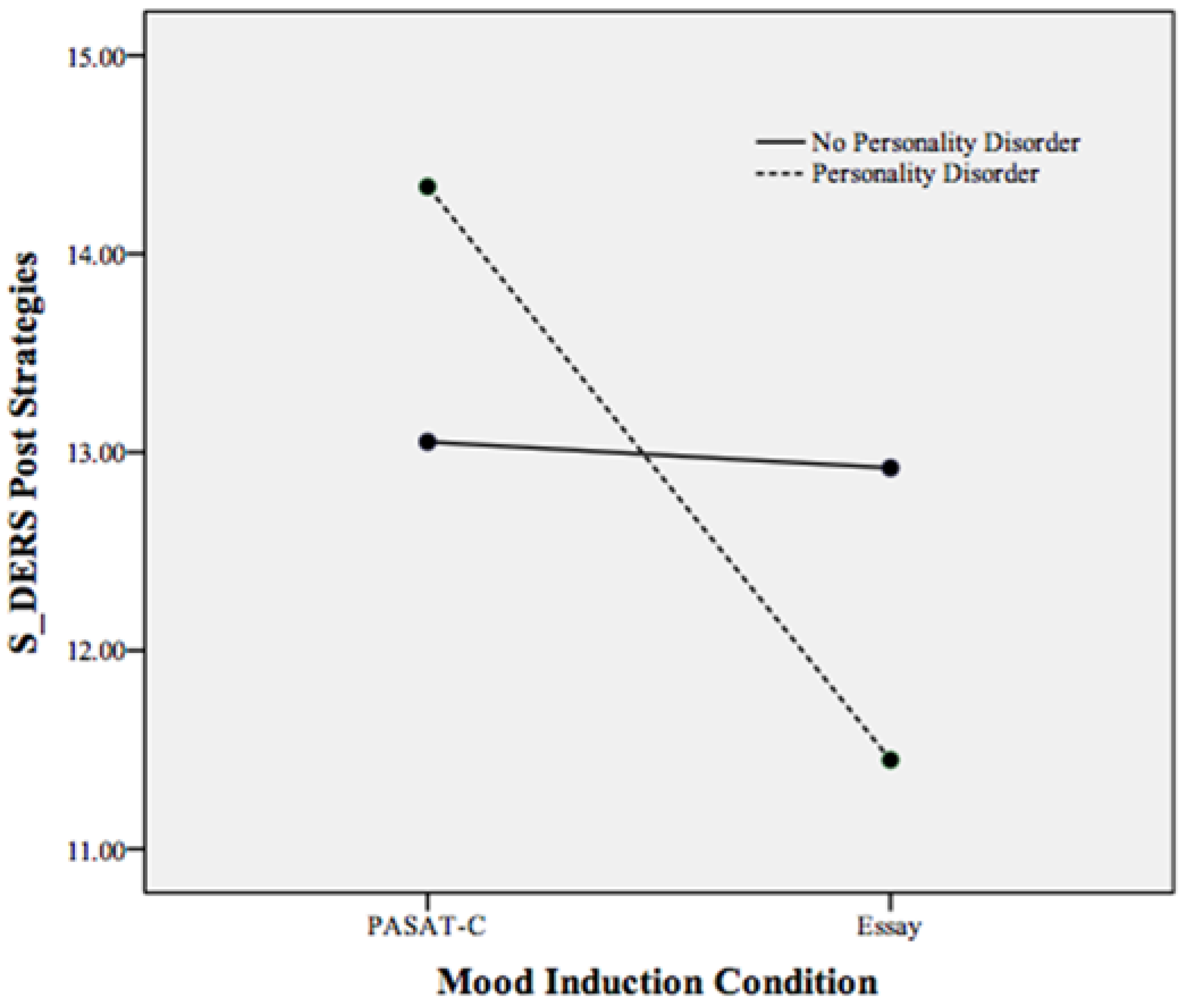
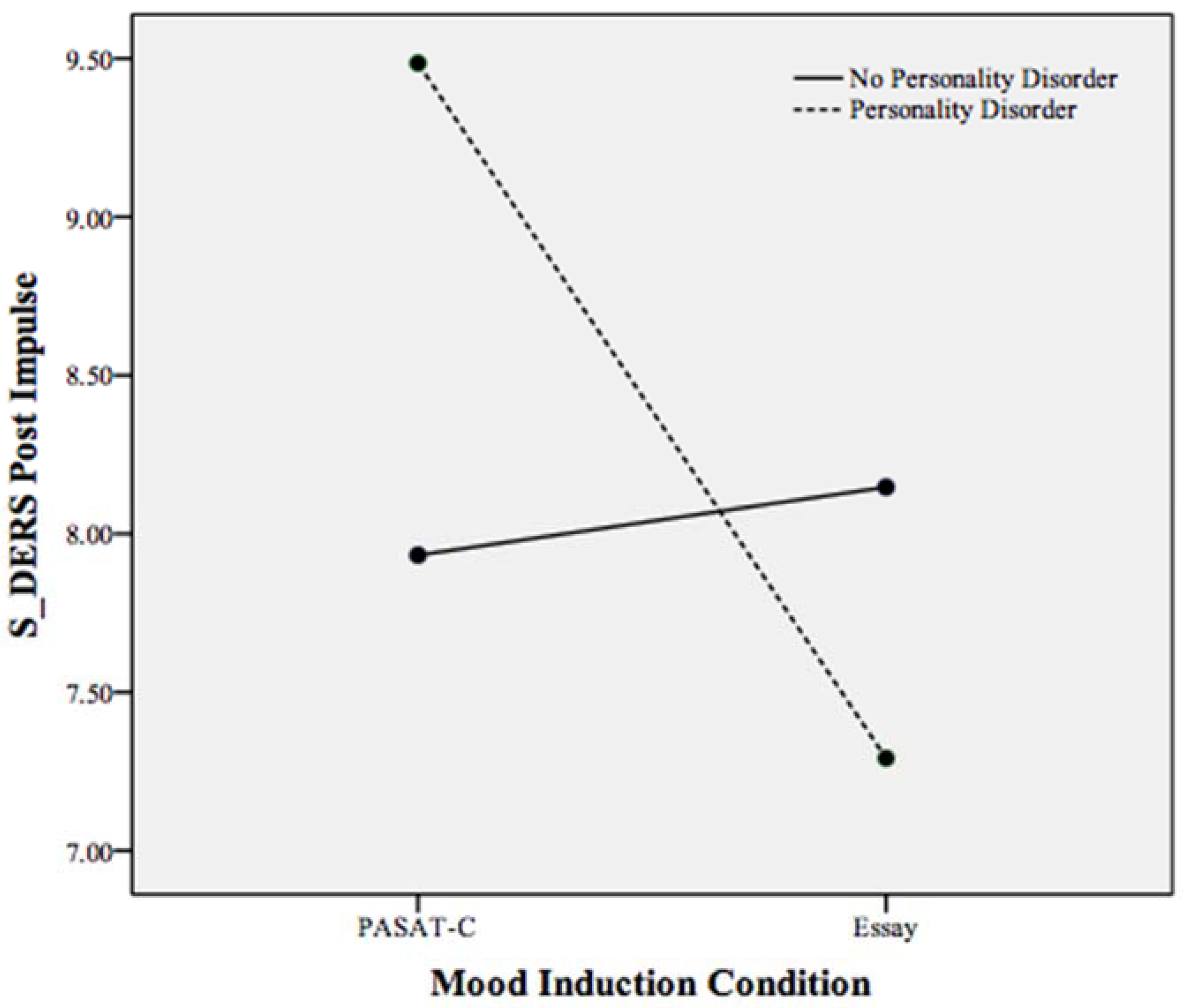
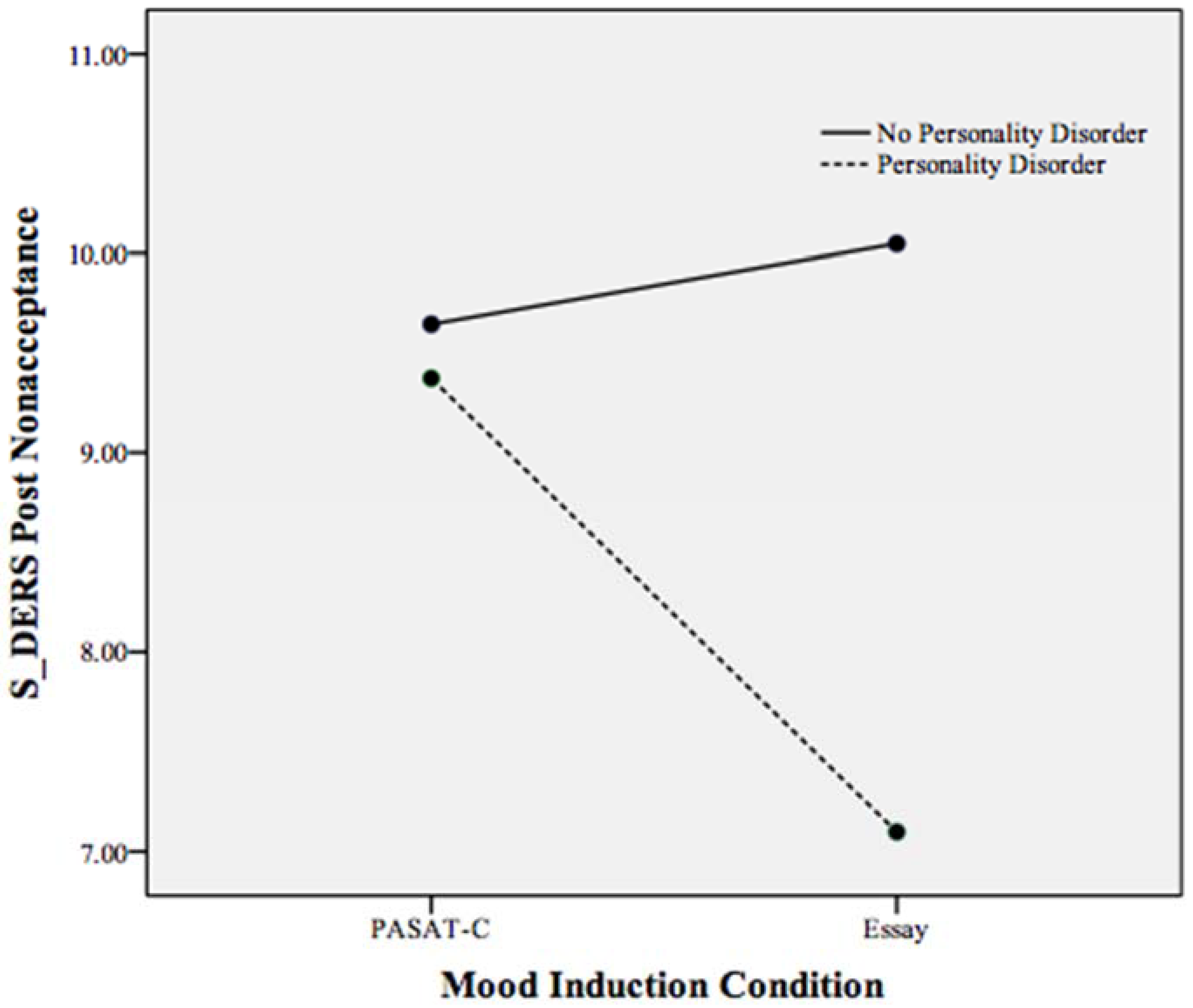
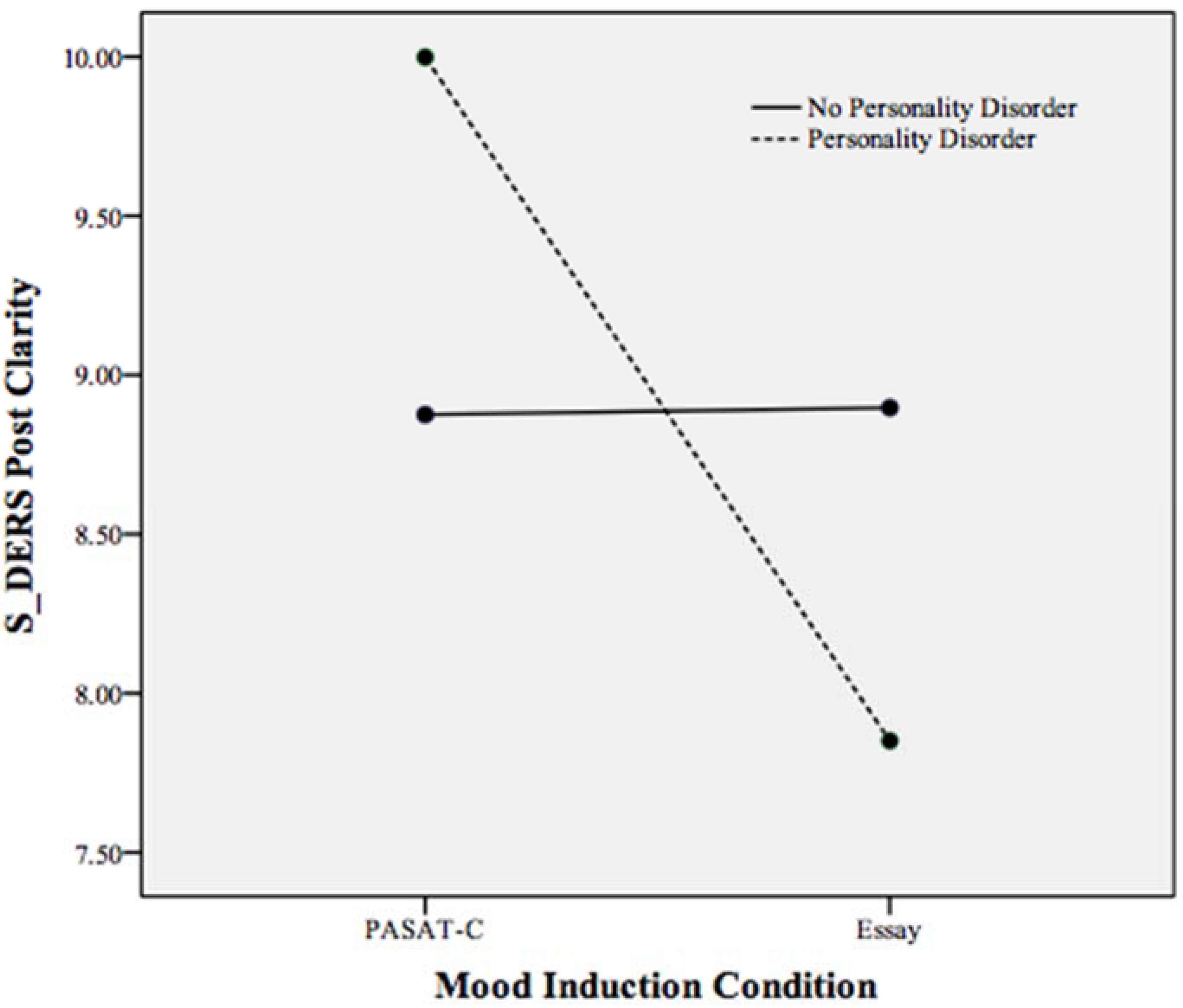
3.4. Follow-Up Analyses
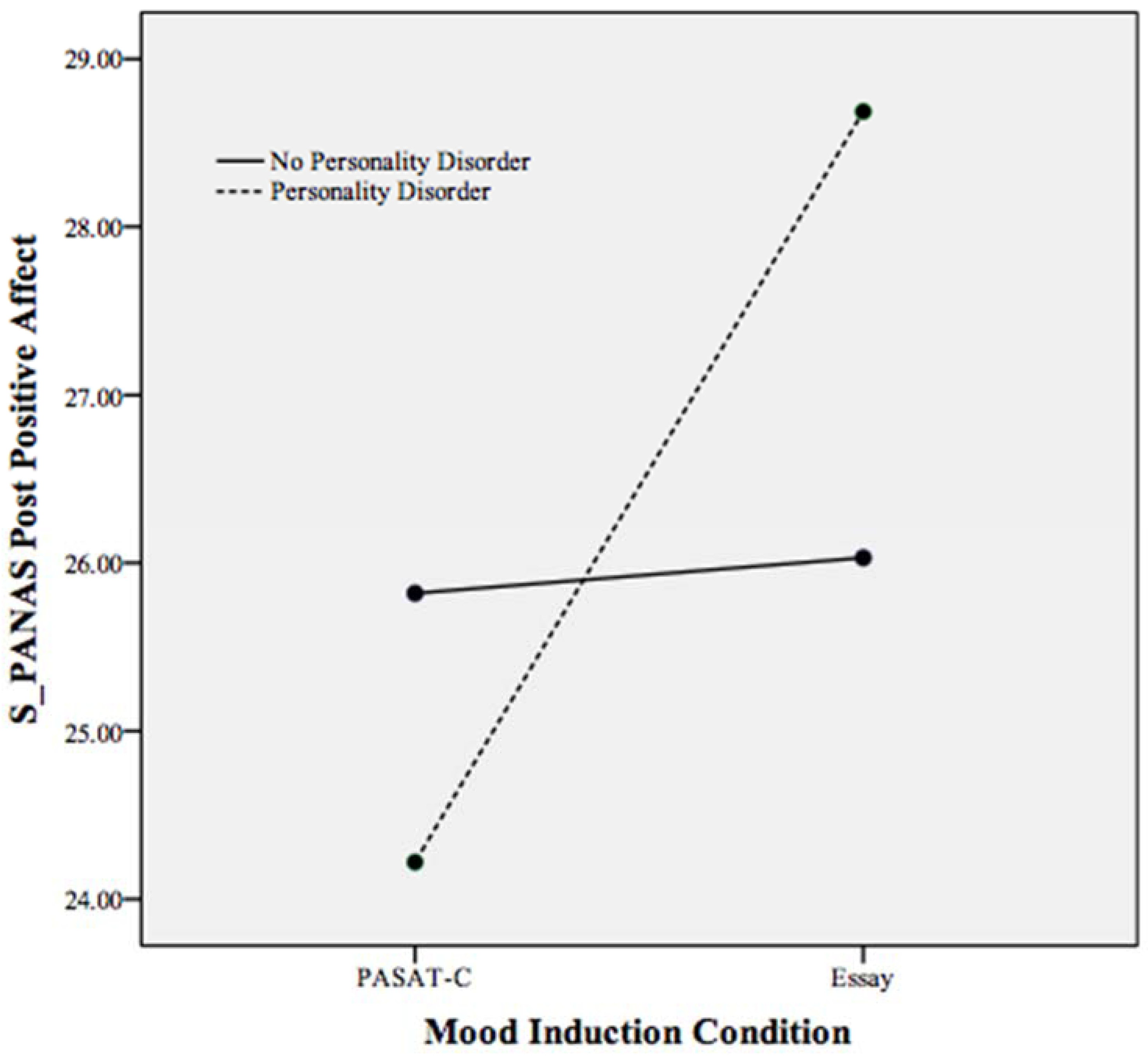
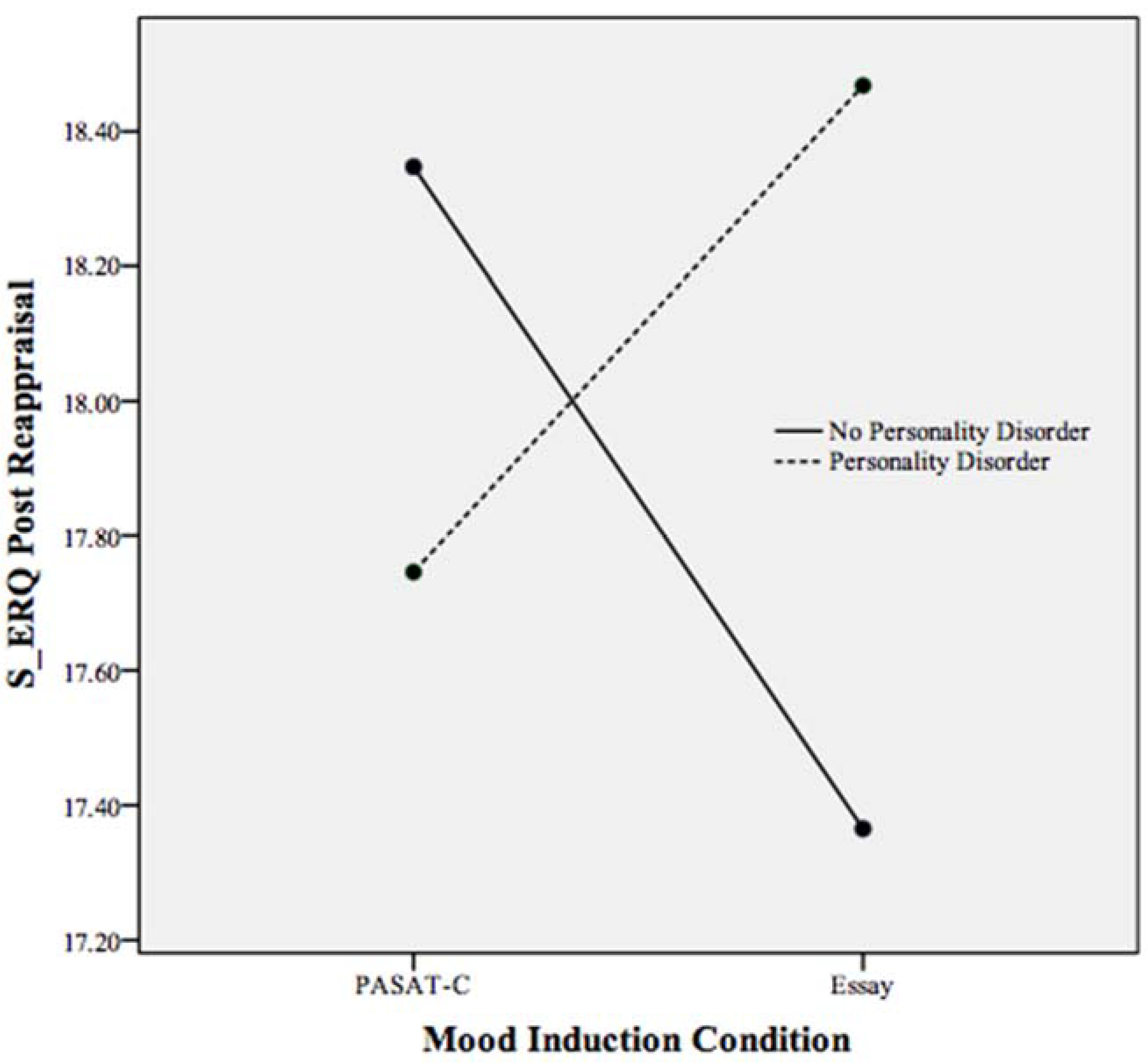
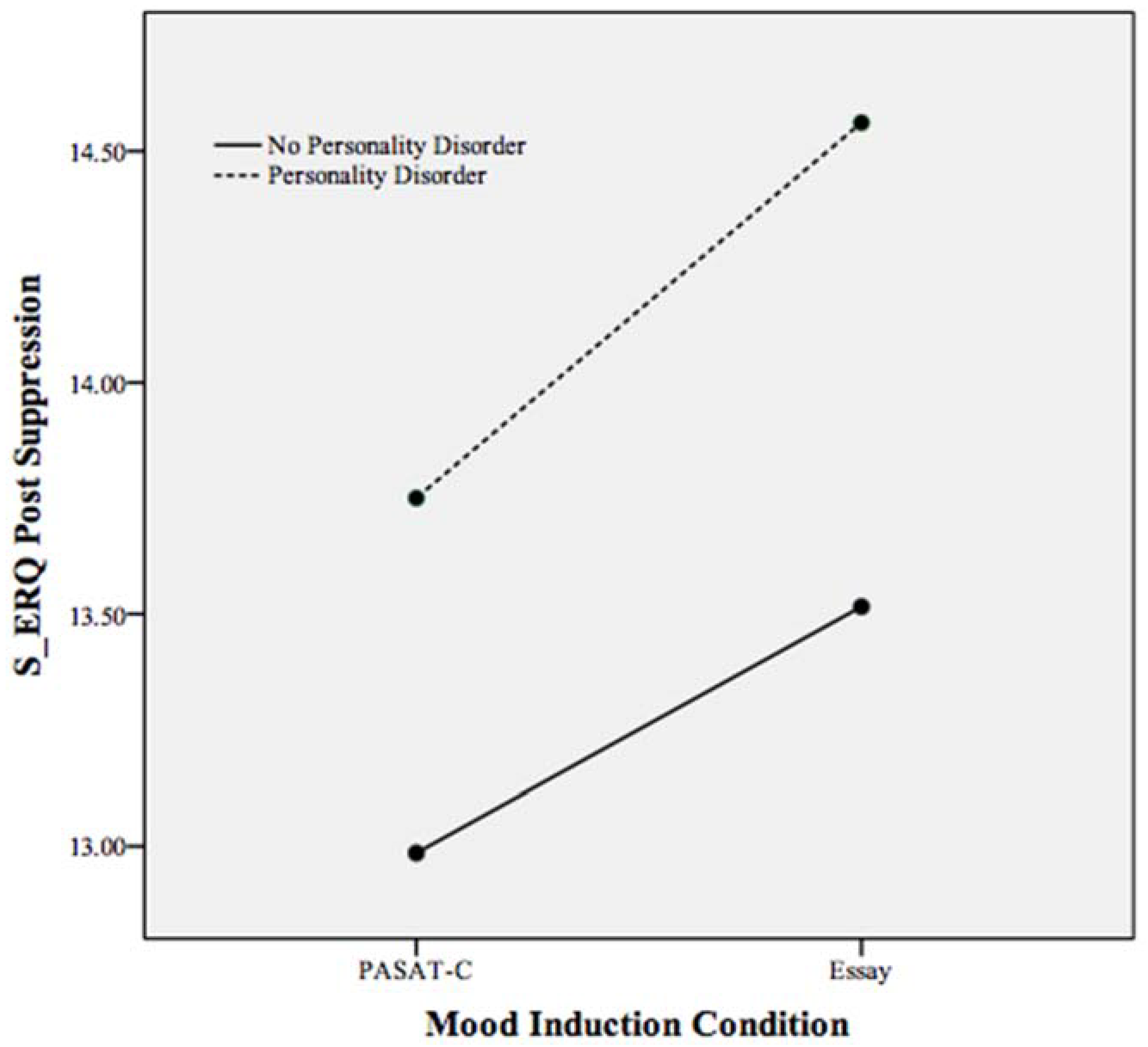
4. Discussion
5. Limitations
6. Future Directions
7. Conclusions
Author Contributions
Conflicts of Interest
References
- Fruzzetti, A.E.; Shenk, C.; Hoffman, P.D. Family interaction and the development of borderline personality disorder: A transactional model. Dev. Psychopathol. 2005, 17, 1007–1030. [Google Scholar] [CrossRef] [PubMed]
- Herr, N.R.; Rosenthal, M.Z.; Geiger, P.J.; Erikson, K. Difficulties with emotion regulation mediate the relationship between personality disorder symptom severity and interpersonal problems. Personal. Ment. Health 2013, 7, 191–202. [Google Scholar] [CrossRef] [PubMed]
- Gratz, K.L.; Tull, M.T.; Baruch, D.E.; Bornovalova, M.A.; Lejuez, C.W. Factors associated with co-occurring borderline personality disorder among inner-citry substance users: the roles of childhood maltreatment, negative affect intensity/reactivity, and emotion dysregulation. Compr. Psychiatry 2008, 49, 603–615. [Google Scholar] [CrossRef] [PubMed]
- Putnam, K.M.; Silk, K.R. Emotion dysregulation and the development of borderline personality disorder. Dev. Psychopathol. 2005, 14, 899–925. [Google Scholar]
- Donahue, J.J.; McClure, K.S.; Moon, S.M. The relationship between emotion regulation difficulties and psychopathic personality characteristics. Personal. Disord. Theory Res. Treat. 2014, 5, 186–194. [Google Scholar] [CrossRef]
- Taylor, J.; Reeves, M.; James, L.; Bobadilla, L. Disinhibitory trait profile and its relation to cluster B personality disorder features and substance use problems. Eur. J. Personal. 2006, 20, 271–284. [Google Scholar] [CrossRef]
- Marissen, M.; Mathijs, L.; Franken, I.H.A. Disturbed emotion recognition in patients with narcissistic personality disorder. Psychiatry Res. 2012, 198, 269–273. [Google Scholar] [CrossRef] [PubMed]
- Gratz, K.L.; Tull, M.T.; Matusiewicz, A.M.; Breetz, A.A.; Lejuez, C.W. Multimodal examination of emotion regulation difficulties as a function of co-occurring avoidant personality disorder among women with borderline personality disorder. Personal. Disord. Theory Res. Treat. 2013, 4, 304–314. [Google Scholar] [CrossRef]
- Suvak, M.K.; Sege, C.T.; Sloan, D.M.; Shea, M.T.; Yen, S.; Litz, B.T. Emotional processing in borderline personality disorder. Personal. Disord. Theory Res. Treat. 2012, 3, 273–282. [Google Scholar] [CrossRef]
- Rosenthal, M.Z.; Kim, K.; Herr, N.R.; Smoski, M.J.; Cheavens, J.S.; Lynch, T.R.; Kosson, D.S. Speed and accuracy of facial expression classification in avoidant personality disorder: A preliminary study. Personal. Disord. Theory Res. Treat. 2011, 2, 327–334. [Google Scholar] [CrossRef]
- American Psychiatric Association. Diagnostic and Statistical Manual of Mental Disorders, 5th ed.; American Psychiatric Publishing: Arlington, VA, USA, 2013. [Google Scholar]
- Gratz, K.L.; Roemer, L. Multidimensional assessment of emotion regulation and dysregulation: Development, factor structure, and initial validation of the difficulties in emotion regulation scale. J. Psychopathol. Behav. Assess. 2004, 26, 41–54. [Google Scholar] [CrossRef]
- Glenn, C.R.; Klonsky, E.D. Emotion dysregulation as a core feature of borderline personality disorder. J. Personal. Disord. 2009, 23, 20–28. [Google Scholar] [CrossRef]
- Salsman, N.L.; Linehan, M.M. An investigation of the relationships among negative affect, difficulties in emotion regulation, and features of borderline personality disorder. J. Psychopathol. Behav. Assess. 2012, 34, 260–267. [Google Scholar] [CrossRef]
- Lejuez, C.W.; Kahler, C.W.; Brown, R.A. A modified computer version of the paced auditory serial addition task (PASAT) as a laboratory-based stressor. Behav. Ther. 2003, 26, 290–293. [Google Scholar]
- Gratz, K.L.; Rosenthal, M.Z.; Tull, M.T.; Lejuez, C.W.; Gunderson, J.G. An experimental investigation of emotion dysregulation in borderline personality disorder. J. Abnorm. Psychol. 2006, 115, 850–855. [Google Scholar] [CrossRef] [PubMed]
- Daughters, S.B.; Sargeant, M.N.; Gratz, K.L.; Bornovalova, M.A.; Lejuez, C.W. The relationship between distress tolerance and antisocial personality disorder among male inner-city treatment seeking substance users. J. Personal. Disord. 2008, 22, 509–524. [Google Scholar] [CrossRef]
- Sargeant, M.N.; Daughters, S.B.; Curtin, J.J.; Schuster, R.; Lejuez, C.W. Unique roles of antisocial personality disorder and psychopathic traits in distress tolerance. J. Abnorm. Psychol. 2011, 120, 987–992. [Google Scholar] [CrossRef] [PubMed]
- Hopwood, C.J.; Wright, A.G.C.; Ansell, E.B.; Pincus, A.L. The interpersonal core of personality pathology. J. Personal. Disord. 2013, 97, 270–295. [Google Scholar] [CrossRef]
- Dixon-Gordon, K.L.; Chapman, A.L.; Lovasz, N.; Walters, K. Too upset to think: The interplay of Borderline Personality features, negative emotions, and social problem solving in the laboratory. Personal. Disord. Theory Res. Treat. 2011, 2, 243–260. [Google Scholar] [CrossRef]
- Kuo, J.R.; Linehan, M.M. Disentangling emotional processes in Borderline Personality Disorder: Physiological and self-reported assessment of biological vulnerability, baseline intensity, and reactivity to emotionally evocative stimuli. J. Abnorm. Psychol. 2009, 118, 531–544. [Google Scholar] [CrossRef] [PubMed]
- Lawrence, K.A.; Chanen, A.M.; Allen, J.S. The effect of ostracism upon mood in youth with borderline personality disorder. J. Personal. Disord. 2011, 25, 702–714. [Google Scholar] [CrossRef]
- Schmahl, C.G.; Elzinga, B.M.; Ebner, U.W.; Simms, T.; Sanislow, C.; Vermetten, E.; Douglas, B.J. Psychophysiological reactivity to traumatic and abandonment scripts in borderline personality and posttraumatic stress disorders: A preliminary report. Psychiatr. Res. 2004, 126, 33–42. [Google Scholar] [CrossRef]
- Bushman, B.J.; Baumeister, R.F. Threatened egoism, narcissism, self-esteem, and direct and displaced aggression: Does self-love or self-hate lead to violence? J. Personal. Soc. Psychol. 1998, 75, 219–229. [Google Scholar] [CrossRef]
- Blanco, C.; Okuda, M.; Wright, C.; Hasin, D.S.; Grant, B.F.; Liu, S.-M.; Olfson, M. Mental health of college students and their non-college-attending peers: Results from the national epidemiologic study on alcohol and related conditions. Arch. Gen. Psychiatry 2008, 65, 1429–1437. [Google Scholar] [CrossRef] [PubMed]
- Clark, L. Schedule for Nonadaptive and Adaptive Personality-2; University of Minnesota Press: Minneapolis, MN, USA, 2003; Unpublished test booklet. [Google Scholar]
- Calabrese, W.R.; Rudick, M.M.; Simms, L.J.; Clark, L.A. Development and validation of the big four personality scales for the Schedule for Nonadaptive and Adaptive Personality—2nd Edition (SNAP-2). Psychol. Assess. 2012, 24, 751–763. [Google Scholar] [CrossRef] [PubMed]
- Watson, D.; Clark, L.A.; Tellegen, A. Development and validation of brief measures of positive and negative affect: The PANAS scales. J. Personal. Soc. Psychol. 1988, 54, 1063–1070. [Google Scholar] [CrossRef]
- Mehrabian, A. Comparison of the PAD and PANAS as models for describing emotions and for differentiating anxiety from depression. J. Psychopathol. Behav. Assess. 1997, 19, 331–357. [Google Scholar] [CrossRef]
- Killgore, W.D.S. Evidence for a third factor on the positive and negative affect scale in a college student sample. Percept. Mot. Skills 2000, 90, 147–152. [Google Scholar] [CrossRef] [PubMed]
- Kashdan, T.B.; Steger, M.F. Expanding the topography of social anxiety: An experience sampling assessment of positive emotions and events, and emotion suppression. Psychol. Sci. 2006, 17, 120–128. [Google Scholar] [CrossRef] [PubMed]
- Gross, J.J.; John, O.P. Individual differences in two emotion regulation processes: Implications for affect, relationships, and well-being. J. Personal. Soc. Psychol. 2003, 85, 348–362. [Google Scholar] [CrossRef]
- Lavender, J.M.; Tull, M.T.; DiLillo, D.; Messman-Moore, T.; Gratz, K.L. Development and Validation of a State-Based Measure of Emotion Dysregulation: The State Difficulties in Emotion Regulation Scale (S-DERS). Under Review.
- Larsen, R.J.; Diener, E. Affect intensity as an individual difference characteristic: A review. J. Res. Personal. 1987, 21, 1–39. [Google Scholar] [CrossRef]
- Baer, R.A.; Smith, G.T.; Hopkins, J.; Krietemeyer, J.; Toney, L. Using self-report assessment methods to explore facets of mindfulness. Assessment 2006, 13, 27–45. [Google Scholar] [CrossRef] [PubMed]
- Bushman, B.J.; Baumeister, R.F.; Phillips, C.M. Do people aggress to improve their mood? Catharsis beliefs, affect regulation opportunity, and aggressive responding. Personal. Soc. Psychol. 2001, 81, 17–32. [Google Scholar] [CrossRef]
- Widiger, T.A.; Clark, L.A. Toward DSM-V and the classification of psychopathology. Psychol. Bull. 2000, 126, 946–963. [Google Scholar] [CrossRef] [PubMed]
- Widiger, T.A.; Samuel, D.B. Diagnostic categories or dimensions? A question for the Diagnostic and Statistical Manual of Mental Disorders-Fifth Edition. J. Abnorm. Psychol. 2005, 114, 494–504. [Google Scholar] [CrossRef] [PubMed]
- Skodol, A.E.; Gunderson, J.G.; Pfohl, B.; Widiger, T.A.; Livesly, W.J.; Siever, L.J. The borderline diagnosis I: psychopathology, comorbidity, and personality structure. Biol. Psychiatry 2002, 51, 936–950. [Google Scholar] [CrossRef] [PubMed]
- Tabachnick, B.G.; Fidell, L.S. Using Multivariate Statistics, 5th ed.; Allyn & Bacon/Pearson Education: Boston, MA, USA, 2007. [Google Scholar]
- Chapman, A.L.; Rosenthal, Z.; Leung, D.W. Emotion suppression in borderline personality disorder: An experience sampling study. J. Personal. Disord. 2009, 23, 29–47. [Google Scholar] [CrossRef]
- Goldin, P.R.; McRae, K.; Ramel, W.; Gross, J.J. The neural bases of emotion regulation: Reappraisal and suppression of negative emotion. Biol. Psychiatry 2008, 63, 577–586. [Google Scholar] [CrossRef] [PubMed]
- Stasiewicz, P.R.; Bradizza, C.M.; Gudleski, G.D.; Coffey, S.F.; Schauch, R.C.; Bailey, S.T.; Gulliver, S.B. The relationship of alexithymia to emotional dysregulation within an alcohol dependent treatment sample. Addict. Behav. 2012, 37, 469–476. [Google Scholar] [CrossRef] [PubMed]
- Gunderson, J. Revising the borderline diagnosis for the DSM-V: An alternative proposal. J. Personal. Disord. 2010, 24, 694–708. [Google Scholar] [CrossRef]
- Moriya, J.; Takahashi, Y. Depression and interpersonal stress: The mediating role of emotion regulation. Motiv. Emot. 2013, 37, 600–608. [Google Scholar] [CrossRef]
- Mennin, D.S.; Heimberg, R.G.; Turk, C.L.; Fresco, D.M. Preliminary evidence for an emotion dysregulation model of generalized anxiety disorder. Behav. Res. Ther. 2005, 43, 1281–1310. [Google Scholar] [CrossRef] [PubMed]
- Klemanski, D.H.; Mennin, D.S.; Borelli, J.K.; Morrissey, P.M.; Aikins, D.E. Emotion-related regulatory deficits contribute to negative psychological outcomes in active-duty Iraq war soldiers with and without posttraumatic stress disorder. Depress. Anxiety 2012, 29, 621–628. [Google Scholar] [CrossRef] [PubMed]
© 2015 by the authors; licensee MDPI, Basel, Switzerland. This article is an open access article distributed under the terms and conditions of the Creative Commons Attribution license (http://creativecommons.org/licenses/by/4.0/).
Share and Cite
Borges, L.M.; Naugle, A.E. An Experimental Examination of the Interaction between Mood Induction Task and Personality Psychopathology on State Emotion Dysregulation. Behav. Sci. 2015, 5, 70-92. https://doi.org/10.3390/bs5010070
Borges LM, Naugle AE. An Experimental Examination of the Interaction between Mood Induction Task and Personality Psychopathology on State Emotion Dysregulation. Behavioral Sciences. 2015; 5(1):70-92. https://doi.org/10.3390/bs5010070
Chicago/Turabian StyleBorges, Lauren M., and Amy E. Naugle. 2015. "An Experimental Examination of the Interaction between Mood Induction Task and Personality Psychopathology on State Emotion Dysregulation" Behavioral Sciences 5, no. 1: 70-92. https://doi.org/10.3390/bs5010070
APA StyleBorges, L. M., & Naugle, A. E. (2015). An Experimental Examination of the Interaction between Mood Induction Task and Personality Psychopathology on State Emotion Dysregulation. Behavioral Sciences, 5(1), 70-92. https://doi.org/10.3390/bs5010070





